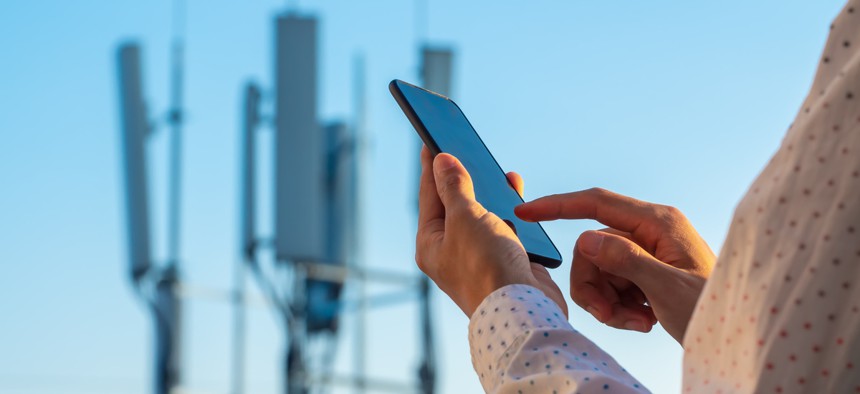How Government Leaders Are Redefining Citizen Services with 5G
Amid the COVID-19 pandemic, government agencies are looking for ways to continue delivering critical services to citizens. Here’s how 5G can help.
Presented by
CommScope

The COVID-19 pandemic has changed American life in ways many of us could never have imagined. Work, education and travel, for example, look much different today than they did at this time last year, and in many ways, this “new normal” is here to stay — at least for a while.
As a result, government agencies are looking for ways to continue delivering critical services to citizens, while providing increased testing capabilities, improving access to healthcare in vulnerable communities and finding a vaccine.
5G could help take some of the load off.
The State of 5G Today
5G, the fifth-generation telecommunications technology, has long promised to deliver wireless data faster, with lower latency, higher reliability and more efficiency than its 4G predecessor. Today, agencies are looking to leverage its speed and reliability to better serve the public interest.
It’s been a long time coming. In 2015, the Federal Communications Commission established the Citizens Broadband Radio Service. CBRS is a band of radiofrequency spectrum from 3.5GHz to 3.7GHz. It is shared by three types of users: incumbent access users, priority access licensees and general authorized users. CBRS’s spectrum allocation systems (SAS) were created to enable people to share the spectrum, paving the way for the increased speed and reliability of 5G.
“It’s a unique time for wireless,” CommScope Chief Technology Officer Morgan Kurk said at a Federal Executive Forum event on 5G. “5G adds flexibility, improves speed, and uses spectrum more efficiently.”
In 2020, the FCC Wireless Telecommunications Bureau and the Office of Engineering and Technology authorized CommScope as a spectrum access systems administrator, giving it the green light to begin commercial deployments of CBRS.
CommScope also announced the deployment of new antenna solutions for macro towers and small cells, which will help begin the build cycle and turn 5G from a concept into a reality.
Kurk recognizes that the need for fast and reliable service is even more important today in many different scenarios. For example, as the COVID-19 pandemic continues to put pressure on hospital beds and testing sites across the country, connectivity becomes more critical for sharing information or communicating with loved ones. CommScope is working with a VA hospital to provide these services to staff and patients during this time. By providing the hospital with a cost-effective, easy-to-install solution that effectively solves these problems, VA hospital staff can spend more time treating their patients.
“In the age of COVID, [reliable communication] is critical, not just for the people working at the hospitals, but also for the patients who have an acute need to avoid being isolated,” Kurk explained. “What we try to do is provide ubiquitous coverage to facilities and campuses, and allow any device to connect anywhere, anytime.”
As COVID-19 continues to spread and flu season approaches, Kurk says these types of capabilities will become even more important.
“This is just the tip of the iceberg in terms of enabling high-need areas for wireless coverage and then onboarding lots of devices, connecting humans and machines,” he said.
Looking To the Future
Over the next couple of years, Kurk expects 5G to play a larger role in government operations. After all, the technology boasts a number of advantages, including greater spectral efficiency and flexibility, higher reliability and speed and lower latency. These capabilities enable the network to support augmented reality (AR) and virtual reality (VR) while mobile. 5G will allow people to “experience things in ways they haven’t been able to experience them before,” Kurk said.
In the wake of COVID-19, several organizations have adopted new technology aimed at helping keep citizens safe, healthy and informed. Take telehealth, for example. Collaboration tools like Zoom and Webex have made it possible for healthcare providers to conduct appointments with patients from home.
But 5G could take these capabilities a step further. Instead of simply communicating with a doctor through a screen, Kurk explains, 5G is capable of supporting the multitude of sensors and transmitters needed to render the in-person experience remotely.
These concepts may sound something like the plot of a 90s sci-fi movie, but according to Kurk, “science fiction is just reality ahead of its time.”
By that logic, it’s only a matter of time before 5G capabilities help redefine how government agencies serve their constituents.
Click here to find out how CommScope can help your agency embrace the 5G revolution:
This content is made possible by our sponsor CommScope; it is not written by and does not necessarily reflect the views of GovExec’s editorial staff.
NEXT STORY: Building Stronger Public Health through the Pandemic and Beyond







